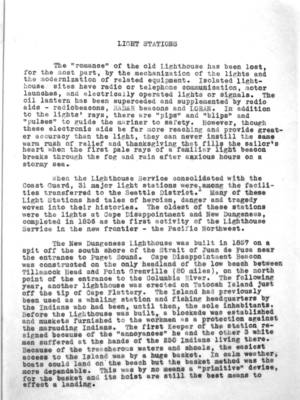Pages That Mention Tillamook Head
Box 247 1899 to 1900 JA land 4000 app 1866 reserved
8
Cape Perpetua, Oreg., reserved by executive order of 8 June, '66. Cape Lookout, Oreg., reserved by executive order of 8 June, '66. False Tillamook, Oreg., reserved by executive order of 8 June, '66. Tillamook Head, Oreg., reserved by executive order of 8 June, '66.
Further information on the subject of light-house reservations in the 13th Light-House District will be forwarded to you for the files of your office as soon as it can be collected and compiled.
Respectfully, ??? Major, Corps of Engineers, U.S.A. Engineer Secretary.
Coast Guard District narrative histories 1945
20
LIGHT STATIONS
The "romance" of the old Lighthouse has been lost, for the most part, by the mechanization of the lights and the modernization of related equipment. Isolated lighthouse sites have radio or telephone communication, motor launches, and electrically operated lights or signals. The oil lantern has been superceded and supplemented by radio aids - raidobeacons, RADAR beacons and LORAN. In addition to the lights' rays, there are "pips" and "blips" and "pulses" to guide the mariner to safety. However, though these electronic aids be far more reaching and provide greater accuracy than the light, they can never instill the same warm rush of relief and thanksgiving that fills the sailor's heart when the first pale rays of a familiar light beacon breaks through the fog and rain after anxious hours on a stormy sea.
When the Lighthouse Service consolidated with the Coast Guard, 31 major light stations were among the facilities transferred to the Seattle District.¹ Many of these Light Stations had tales of heroism, danger and tragedy woven into their histories. The oldest of these stations were the lights at Cape Disappointment and New Dungeness, completed in 1856 as the first activity of the Lighthouse Service in the new frontier - the Pacific Northwest.
The New Dungeness Lighthouse was built in 1857 on a spit off the south shore of the Strait of Juan de Fuca near the entrance to Puget Sound. Cape Disappointment Beacon was constructed on the only headland of the low beach between Tillamook Head and Point Grenville (80 miles), on the north point of the entrance to the Columbia River. The following year, another lighthouse was erected on Tatoosh Island just off the tip of Cape Flattery. The Island had previously been used as a whaling station and fishing headquarters by the Indians who had been, until then, the sole inhabitants. Before the Lighthouse was built, a blockade was established and muskets furnished to the workmen as protection against marauding Indians. The first Keeper of the station resigned because of the "annoyances" he and the other 3 white men suffered at the hands of the 250 Indians living there. Because of the treacherous waters and shoals, the easiest access to the Island was by a huge basket. In calm weather, boats could land on the beach but the basket method was the more dependable. This was by no means a "primitive" devise, for the basket and its hoist are still the best means to effect a landing.
21
In the quite rapid succession, Umpqua River, Willapa Bay, Smith Island, Ediz Hook, Cape Arago, Cape Blanco, Point No Point, Point Wilson, and Yaquina Bay Lighthouses were built. In 1879, construction began on the Tillamook Rock Beacon.
Tillamook Rock Lighthouse was one of the most famous as well as one of the most exposed stations in the Lighthouse Service, set on a great precipitous rock lying a mile offshore from Tillamook Head on the Oregon Coast. A dark cloud of ill omen shadowed the station as, in the landing of the construction party, the superintendent was swept by a great wave into the sea and drowned. Almost insurmountable obstacles faced the engineers, for the entire top of the rock mass had to be blasted level to provide space for the lighthouse and its accompanying structures. Heavy seas continually washed over the Rock carrying away half finished foundations, equipment and endangering the lives of the entire work party. Although the light stood 133 feet above the water, on many occasions tremendous waves swept completely over the station carrying large fragments of rock which caused considerable damage to the station. On one such occasion, a rock weighting 135 pounds was hurled through the roof of the building and into the quarters below, causing extensive damage. Another time, the sea tossed a boulder through the lantern, extinguished the light and flooded the dwelling below.
West Point, built in 1881, Alki Point and Brown Point, built in 1887 and Destruction Island, built in 1891, were the next light stations to be erected. Here again, at Destruction Island, treacherous seas made landings difficult except in calm weather, so the "basket" and boom were again called upon for safe landings on the station. 14 other lighthouses were established in the Seattle District, the last being the Lim Kiln structure in 1914. Strangely enough, the Lime Kiln Lighthouse was the last light station in the District operating an oil lantern. An attempt was made to electrify the light by extending commercial power to the Station but the Power Company was unable to furnish sufficient current; in the same regard, poles had to be set in a solid rock and the cost and labor for this were almost prohibitive. A request was made for Headquarters' approval to install a power plant at the unit but this was not commensurate with Headquarters' policy so the light remained an incandescent oil vapor type. This type, familiarly known as i.o.v., gave good service although its range could not match that of the newer electric light. The old i.o.v. light came in two sizes and was approximately equivalent
-2-


